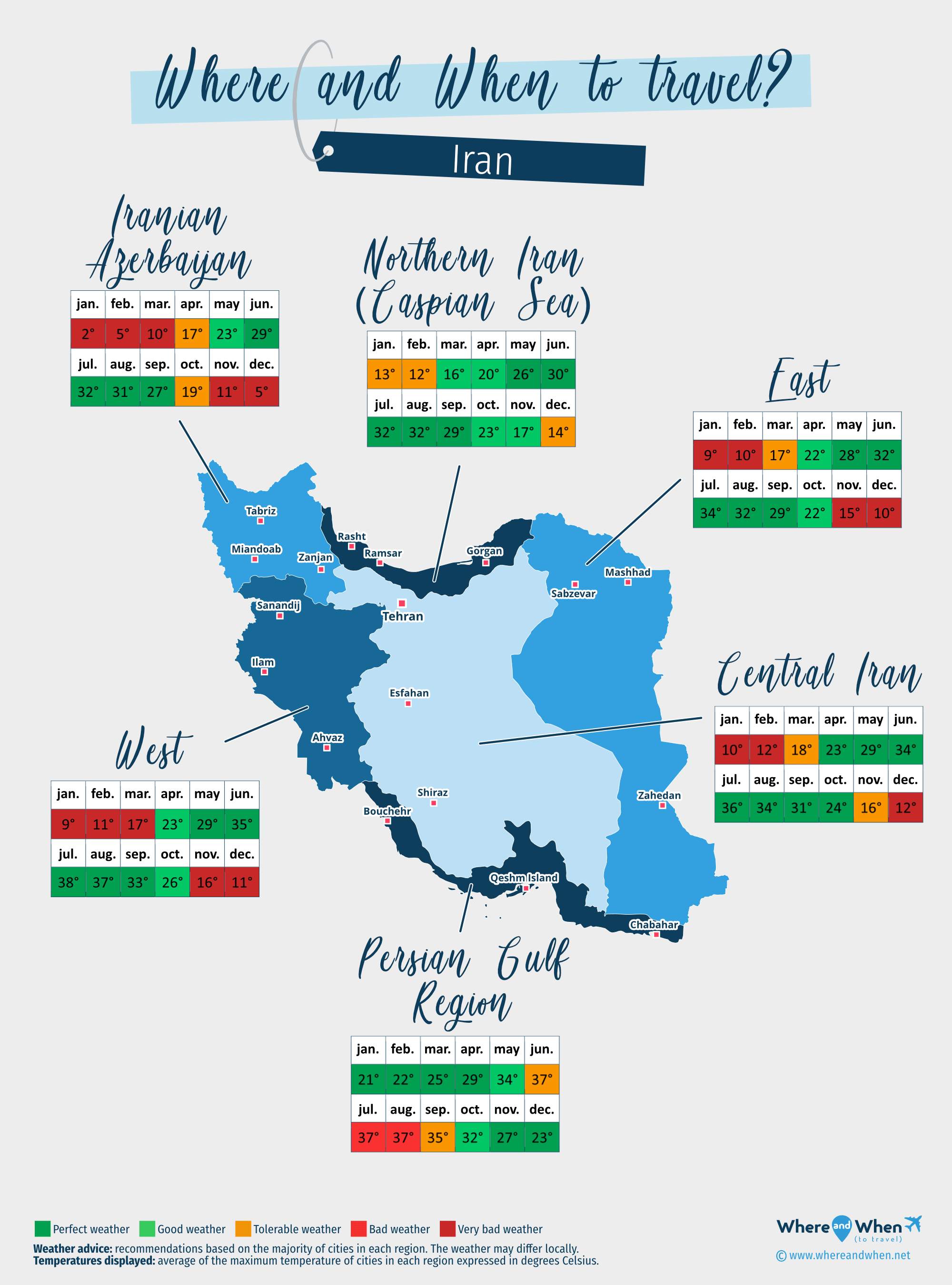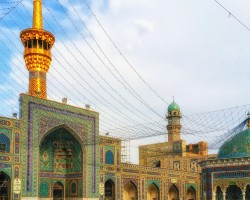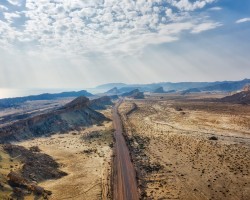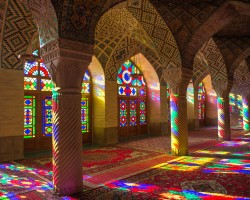Best time to go to Iran for a perfect weather and where to go?
When is the best time to go to Iran?
If you want to explore several regions, the best time to travel to Iran is from March to October, with a preference for the shoulder seasons. However, due to its great climatic diversity, the country can be visited year-round:
- In spring, from mid-March to early June, temperatures are pleasant almost everywhere, with contrasts depending on altitude, and rainfall is low, except in the northwest where it can rain until the end of April. The further into the season, the more summery the weather becomes. It's a great time to go to Iran!
- In summer, from June to mid-September, temperatures can soar, especially in regions near the Persian Gulf. On the central plateau, where most tourist sites are located, it is hot, but not excessively so. By avoiding midday hours, traveling during this period is therefore perfect. Moreover, it's also a good time for a beach break in the Caspian Sea region.
- In autumn, from mid-September to mid-November, the atmosphere is mild and conducive to a stay throughout the country. The ideal time to leave is at the beginning of the season, as temperatures drop quickly from the start of November.
- In winter, from mid-November to mid-March, the climate can be harsh in Iran. Snow falls abundantly, and when it doesn't, rain can take over. Additionally, temperatures are cool, even cold, in a large part of the country. If you want to go to Iran during this period, opt for the Persian Gulf region where the climate is idyllic, or along the Caspian Sea in the far north.
When to go to Iran based on visitor numbers? It is in April, July, August, and October that there are the most visitors. If you want to escape the crowds and visit in peace while enjoying a favorable climate, the ideal time is to travel in May, June, or September. This works out perfectly, as these are the periods when flight tickets are reasonably priced!
Finally, before you pack your bags, be aware that during Ramadan, the dates of which vary each year, most cities operate at a slower pace and some shops and restaurants remain closed.
Where and when to go based on the weather?

Central Iran
Tehran, Shiraz, Esfahan...
East of Iran
Mashhad, Zahedan, Sabzevar...
Iranian Azerbaijan
Tabriz, Zanjan, Miandoab...
Northern Iran (Caspian Sea)
Gorgan, Rasht, Ramsar...
Persian Gulf Region of Iran
Qeshm Island, Bouchehr, Chabahar...
West of Iran
Ahvaz, Ilam, Sanandij...
To get all the information about the climate and weather in Iran for a specific month, click on the corresponding link below:
Iran in january Iran in february Iran in march Iran in april Iran in may Iran in june Iran in july Iran in august Iran in september Iran in october Iran in november Iran in december
Best time to travel to Iran by cities
Climate and Weather in Iran
Due to its geographical location and its numerous reliefs, the climate of Iran is very diverse. Here are the main trends:
- A dry and cold steppe climate is slightly predominant, as it prevails particularly in the large central area, in the east and northwest of the country.
- A warm Mediterranean climate can be found in the Tehran region, along the Caspian Sea, as well as in certain parts of eastern and western Iran, especially where there are no mountains.
- A hot and dry desert climate is present in almost the entire Persian Gulf region and on Qeshm Island.
- Less commonly, the climate can be of the cold and dry desert type, humid continental that is dry and warm, or even hot and dry steppe.
Iran is a country in the Middle East bordered by Azerbaijan and the Caspian Sea to the north, Turkmenistan, Afghanistan, and Pakistan to the east, the Persian Gulf to the south, and Iraq and Turkey to the west. It also has a maritime border with the United Arab Emirates.
Very vast, the country is
In general, the weather in Iran is therefore very diverse depending on where one is, and the temperature range is significant, both between seasons and also during the same day. Moreover, rainfall is generally quite low throughout the country.

Climate in northern Iran
In northern Iran, along the Caspian Sea, the climate is predominantly Mediterranean. As a result, the weather is milder than elsewhere and travel is possible year-round, with a more favorable period between March and November.
- In winter, from December to February, it is cool, with temperatures ranging from 9 to 16°C (61°F) . In the middle of the day, the sun is generally present, providing a pleasant atmosphere. Some precipitation may occur, but it remains moderate.
- In spring, from March to May, the mercury gradually rises to become summery by the end of the season, with averages around 32°C (90°F) . Occasionally, rain may appear, but it never lasts long.
- In summer, from June to August, it is hot. Expect average temperatures of 36 to 38°C (101°F) during the day and between 25 and 27°C (81°F) at night. In September, temperatures drop, with highs around 33°C (92°F) . Humidity is high during this season, although rainfall remains low.
- In autumn, it becomes increasingly cool, and this is the period when it rains the most. In October, the thermometer is still close to 26°C (79°F) , but in November, it drops below 20°C (68°F) .
Climate in northwestern Iran
While the summer weather is very similar to that of the northern coast, the rest of the year is much colder in this northwestern area. It is therefore preferable to visit between May and September to truly enjoy it.
From October, the mercury drops below 20°C (68°F) , and it is in November that winter truly arrives, with averages around 10°C (50°F) and the first snowfall.
From December to February, temperatures range from 0 to 5°C (41°F) during the day, with January being the coldest month. At night, temperatures are consistently negative and can even reach -10°C at higher altitudes. Snow falls until March, with averages stagnating around 0°C (32°F) at night and gradually rising during the day to 10°C (50°F) .
We will have to wait until April to experience milder temperatures (around 17°C (63°F) ), despite occasional rain, and May for spring to be truly pleasant with averages above 20°C (68°F) .
Climate in eastern, central, and western Iran
Although these three regions experience different types of climate, their weather is quite similar, and the best time to visit them is between April and October.
- In winter, from mid-November to mid-March, daytime temperatures are acceptable, with averages ranging from 9 to 16°C (61°F) . It is at night that it gets really cold: around 0°C (32°F) in the plains and negative averages at higher altitudes. There is little rain during this period, but the weather can be gray.
- In spring, the atmosphere remains cool throughout March, and temperatures only rise starting in April to reach around 23°C (74°F) . In May, the arrival of summer is already felt, with averages around 29°C (85°F) . However, it is the rainiest month of the year in the Tehran region.
- In summer, it is in the west that it gets the hottest, with highs around 38°C (101°F) in July and August. At the same time, temperatures range from 34 to 36°C (97°F) in the center and from 32 to 34°C (94°F) in the east of the country. In September, temperatures drop: expect averages of 33°C (92°F) in the west, 31°C (88°F) in the center, and 29°C (85°F) in the east.
- In autumn, temperatures range from 22 to 26°C (79°F) in October and around 16°C (61°F) in November, with slightly more frequent and intense rains.
Climate in the Persian Gulf region
With its predominantly arid climate, this southern region of the country is the hottest and driest. Unlike the rest of Iran, it is preferable to visit between October and May.
During winter, from December to March, temperatures range from 21 to 25°C (77°F) depending on the area, and sea temperatures are similar. In the interseasons, spring and autumn, temperatures are higher: between 27 and 34°C (94°F) .
Summer is scorching in the Persian Gulf, with an average of 37°C (99°F) from June to August. Depending on the location, the thermometer can easily reach 40°C (104°F) during the day and approach 35°C (95°F) at night.
It rarely rains in this region. Only the winter months are affected by a few short showers, between November and March.
Temperatures and rainfall in Iran
On these 3 graphs, we present the evolution of temperatures of Iran and month-by-month rainfall for the cities of Tehran, Mashhad, Qeshm Island, Shiraz and Ahvaz, as well as the month-by-month sea temperature for coastal cities.
Peak visitor numbers and tourist seasons in Iran
Find out when Iran has its high tourist season (the period when the influx of tourists is highest) and off-peak tourist season using our data and figures.
Tourist seasons in Iran
The months with low numbers of tourists are: January, February, March, May, June, September, November and December. The number of visitors to Iran is high in: April, July, August and October.
- Very low season in Iran: January, February, March, May, June and November.
- Low season in Iran: September and December.
- High season in Iran: July and October.
- Peak season in Iran: April and August.
Figure: Visitor index for Iran month by month
Average price for flights to Iran
A return flight between London and Tehran is generally cheaper if you go in january ($ 322 on average): this is the best time for travellers on a tight budget. In contrast, you may end up paying $ 400 more for your airline ticket to Tehran if you go in august.
Where to go in Iran?
This table allows you to see the maximum temperature for each city and our opinion on the weather month by month (see colour legend below the table).
| Cities | jan. | feb. | mar. | apr. | may | jun. | jul. | aug. | sep. | oct. | nov. | dec. |
| Tehran | 49°F | 52°F | 61°F | 72°F | 85°F | 95°F | 101°F | 99°F | 92°F | 77°F | 59°F | 52°F |
| Mashhad | 49°F | 52°F | 61°F | 70°F | 83°F | 90°F | 94°F | 90°F | 85°F | 72°F | 58°F | 50°F |
| Qeshm Island | 74°F | 76°F | 83°F | 90°F | 99°F | 103°F | 103°F | 101°F | 99°F | 94°F | 85°F | 77°F |
| Shiraz | 56°F | 59°F | 67°F | 76°F | 86°F | 97°F | 99°F | 97°F | 92°F | 81°F | 67°F | 59°F |
| Ahvaz | 68°F | 74°F | 83°F | 95°F | 108°F | 117°F | 121°F | 121°F | 113°F | 101°F | 83°F | 70°F |
| Bouchehr | 70°F | 70°F | 77°F | 86°F | 95°F | 103°F | 104°F | 104°F | 101°F | 94°F | 81°F | 72°F |
| Chabahar | 76°F | 77°F | 85°F | 92°F | 97°F | 97°F | 94°F | 92°F | 92°F | 92°F | 85°F | 79°F |
| Esfahan | 52°F | 58°F | 67°F | 76°F | 86°F | 97°F | 101°F | 97°F | 92°F | 79°F | 63°F | 56°F |
| Gorgan | 58°F | 58°F | 67°F | 74°F | 86°F | 94°F | 95°F | 95°F | 88°F | 77°F | 65°F | 59°F |
| Ilam | 50°F | 54°F | 61°F | 70°F | 83°F | 94°F | 99°F | 99°F | 92°F | 79°F | 63°F | 54°F |
| Miandoab | 41°F | 47°F | 56°F | 68°F | 79°F | 90°F | 97°F | 95°F | 88°F | 74°F | 56°F | 47°F |
| Ramsar | 54°F | 52°F | 56°F | 63°F | 74°F | 81°F | 85°F | 85°F | 79°F | 72°F | 61°F | 56°F |
| Rasht | 56°F | 56°F | 61°F | 67°F | 77°F | 85°F | 88°F | 86°F | 81°F | 74°F | 65°F | 59°F |
| Sabzevar | 47°F | 52°F | 63°F | 74°F | 85°F | 94°F | 97°F | 94°F | 88°F | 74°F | 59°F | 50°F |
| Sanandij | 36°F | 40°F | 49°F | 61°F | 72°F | 85°F | 92°F | 90°F | 79°F | 67°F | 50°F | 41°F |
| Tabriz | 38°F | 41°F | 52°F | 63°F | 74°F | 85°F | 90°F | 90°F | 81°F | 68°F | 52°F | 43°F |
| Zahedan | 58°F | 61°F | 72°F | 81°F | 90°F | 95°F | 99°F | 95°F | 90°F | 81°F | 68°F | 59°F |
| Zanjan | 36°F | 40°F | 50°F | 63°F | 74°F | 83°F | 86°F | 85°F | 79°F | 67°F | 50°F | 40°F |
| Abyaneh | 50°F | 54°F | 67°F | 76°F | 86°F | 95°F | 101°F | 95°F | 90°F | 77°F | 61°F | 52°F |
| Alamut | 41°F | 47°F | 56°F | 67°F | 79°F | 90°F | 94°F | 90°F | 83°F | 70°F | 54°F | 45°F |
Legend:
perfect weather
good weather
tolerable weather
bad weather
very bad weather
About Iran
What can I do in Iran?
Beaches / swimming
Nature and countryside
Culture and heritage
Sports
Family travel
Crafts / shopping
Gastronomy
Nightlife
Is this weather information for Iran reliable?
Climate data for Iran has been gathered every day since January 2009. The analysis of these meteorological data for Iran allows us to determine the average for each month in Tehran, Mashhad, Qeshm Island, Shiraz, Ahvaz, Bouchehr, Chabahar, Esfahan, and 53 other cities.
So yes: this data is reliable except in cases of temporary climate disruption in the region.







